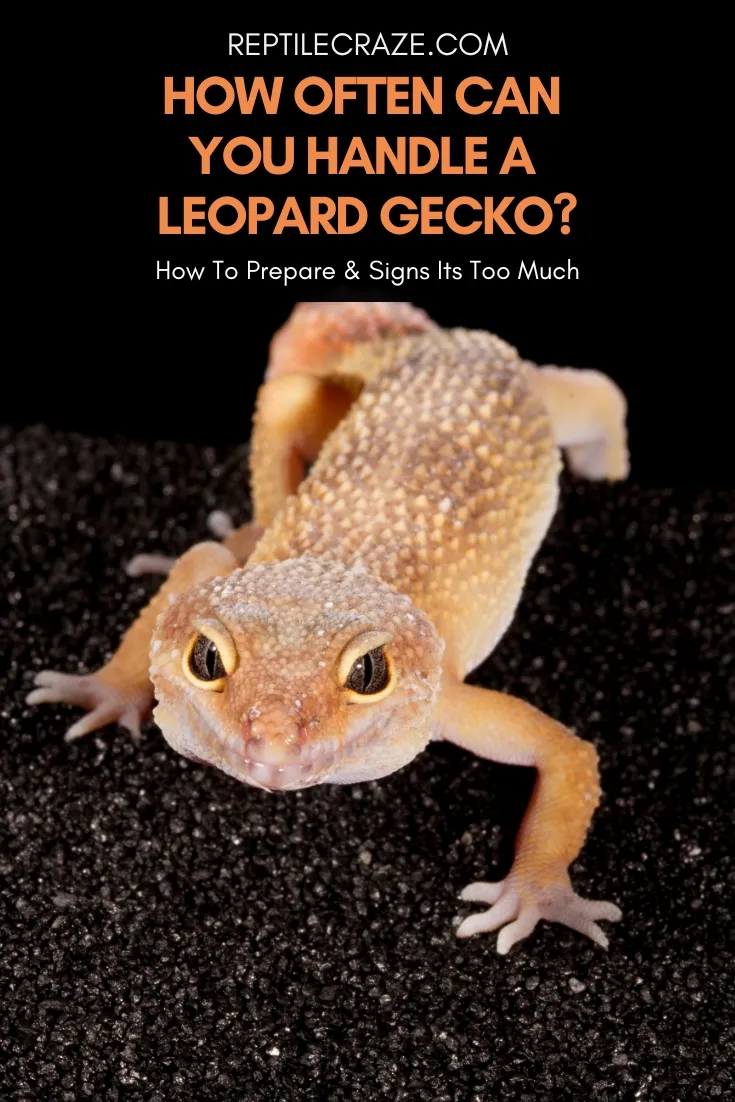
Handling time is an especially exciting part of having a reptile pet such as a leopard gecko. To make sure that handling is fun for both you and your pet, there are a few things to remember.
Adult leopard geckos can be handled 2-3 times per week for up to 15 minutes. Different handling recommendations apply to young, sick, stressed, brumating, shedding or newly purchased individuals. Always wash your hands after handling a reptile, and only handle them in an appropriate environment.
In this article, we’ll explain everything you need to know relating to how often you can handle your leopard gecko such as:
- How often a leopard gecko can be handled.
- Signs that a leopard gecko is overhandled.
- Consequences of handling a leopard gecko too much.
- When not to handle a leopard gecko.
- Precautions to take when handling a leopard gecko.
Aside from handling being a fun part of caring for your leopard gecko, it also gives you a good opportunity to check their health. So let’s get stuck in!
Table of Contents
How Often Can Leopard Geckos Be Handled?
Adult leopard geckos can be handled 2-3 times per week for around 15 minutes. Handling can help you bond with your pet and give you a chance to check them.
We’ll talk later about how to handle your leopard gecko safely. Taking precautions during handling decreases any risks for you and your reptile pet.
Leopard geckos enjoy a solitary life, and may become stressed if handled for more than 15 minutes or more than 2-3 times per week.
Signs Your Leopard Gecko Is Over Handled
Although handling your leopard gecko is very fun, it’s important not to do it too often. Handling a leopard gecko more frequently or for too long can cause them to become stressed.
It can harm the bond between you and your reptile pet. In this section, we’ll explain some signs that your leopard gecko is over-handled.
Negative Behavioral Changes
If you handle your leopard gecko too often, it may start to develop negative feelings about human contact. As a result, they may move when you approach them, try to bite you, or even hide.
If your leopard gecko displays the above behavior or doesn’t seem to be too cooperative when it comes to handling, it’s best to leave it for that day.
Persevering with handling an unhappy leopard gecko could lead to more serious problems, such as them dropping their tail.
They may do this in stressful situations or if too much pressure is applied to the tail.
Tail dropping is a physiological response to help distract predators, which is pretty cool, but not something you want to happen in a pet gecko.
Tail regeneration takes a lot of energy from a leopard gecko, so it’s preferable to avoid it.
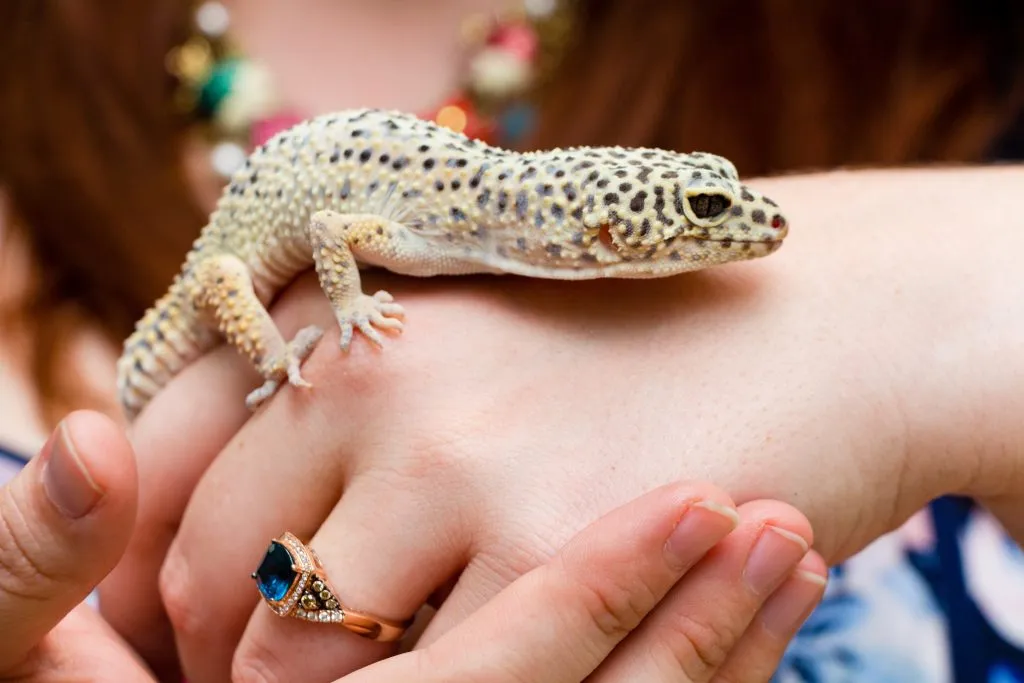
Decreased temperature
Keeping your leopard gecko out of its
It’s important to control the environmental parameters in your gecko’s enclosure to ensure that they are always comfortable and healthy.
Geckos are ectotherms and use the external environment to main their appropriate internal body temperature.
Keeping them outside their
A leopard gecko that is too cold may have difficulty digesting its
Precautions You Should Take When Handling Your Leopard Gecko
Now we’ve explained how often you can handle a leopard gecko, let’s take a look at some precautions to take during handling.
Choose An Appropriate Environment
To make sure that handling time is fun and safe for both you and your leopard gecko, it’s important to handle them in the appropriate environment.
This also increases the chances of your pet having a positive experience.
Handle your leopard gecko in a quiet, calm place, away from other pets to decrease the chances of them becoming stressed or injured.
In terms of human safety, it’s best not to handle leopard geckos in your kitchen, to decrease the possibility of this space becoming contaminated with salmonella.
Pick Them Up Carefully
Leopard geckos are pretty delicate in their own way, so it’s important to be very gentle when handling them. They have thin skin, which can become damaged by grabbing or struggling with them (source).
As we already mentioned, leopard geckos can drop their tail. When you want to pick up your leopard gecko, it’s important to never grab its tail.
Applying pressure to the tail can lead to them dropping it. Generally, if your leopard gecko doesn’t seem too keen when it comes to handling, it’s probably best to leave it and try again another day.
Wash Your Hands After
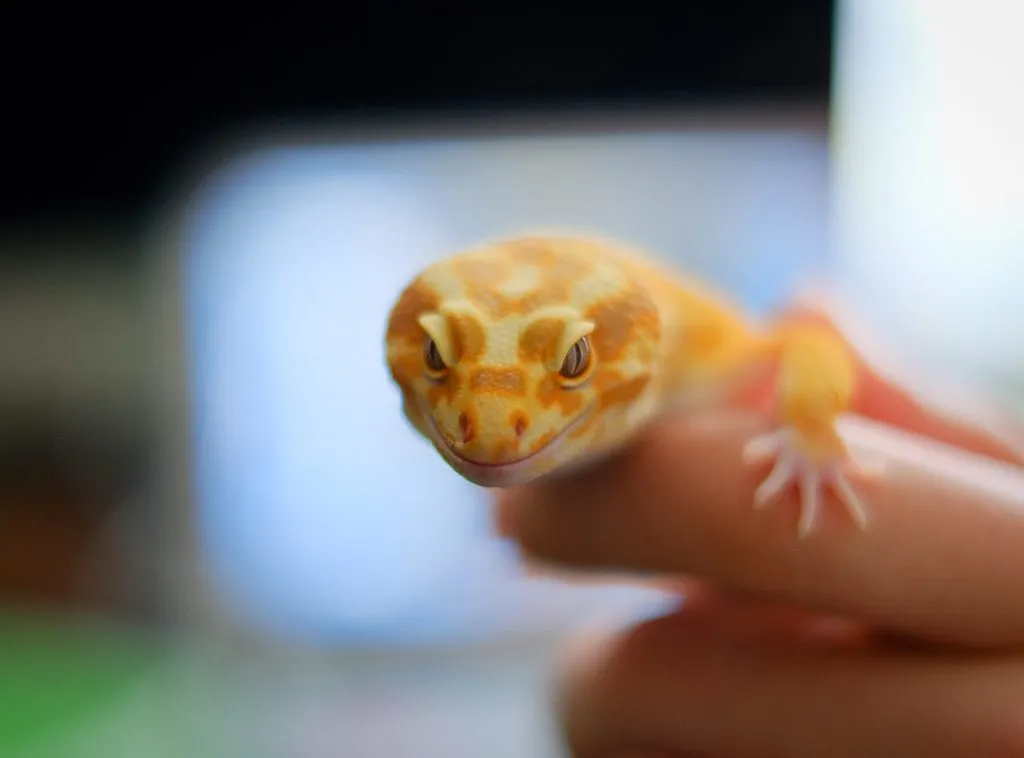
It’s well known that leopard geckos can be a source of bacteria for humans, in particular, the bacteria ‘salmonella’ which is carried by many reptile species (source).
Salmonella infects the gastrointestinal system and can give symptoms in humans such as (source):
- Diarrhea
- Nausea and vomiting
- Stomach cramps
- Fever.
Unless you’re immunocompromised, very young, or very old, salmonellosis usually isn’t a serious disease. Usually, it lasts only a few days and humans can recover without any medicine.
However, there are some rare cases of more serious salmonellosis which require treatment from a doctor. Signs that you need to see a doctor include blood in your feces or a very high fever.
It’s much better to prevent salmonellosis in the first place by washing your hands properly using soap and warm water after handling your leopard gecko.
Don’t forget, anything your leopard gecko touches can also be contaminated with salmonella. For example,
It’s good practice to keep anything your leopard gecko comes into contact with, away from your kitchen.
When it comes to cleaning, it’s better to wash your leopard gecko’s things in a separate area, in the bathroom or outside, and to thoroughly disinfect this area afterward.
Wearing rubber gloves when cleaning your leopard gecko’s
Always be sure to wash your hands after touching anything that has come into contact with your leopard gecko or after performing activities such as feeding them or cleaning their
Leopard geckos are also a source of salmonella for other pets such as cats and dogs. To reduce the risk of another pet catching salmonella from your leopard gecko, try not to let leopard geckos come into contact with shared spaces, such as furniture or bedding.
The Times When You Shouldn’t Handle A Leopard Gecko
In this section, we’ll go through some scenarios when handling a leopard gecko isn’t a good idea.
Underdeveloped Leopard Geckos
Veterinarians recommend waiting until your leopard gecko is 5-6 inches long before starting to handle them (source). It will probably take around 4 months for your leopard gecko to grow to this size.
When they are big enough for handling, it’s best to build up handling time slowly as they get used to human contact.
Handling young animals for too long when they are small, can mean they are less cooperative later when they grow older.
Newly Purchased Leopard Geckos
Bringing your leopard gecko home for the first time is very exciting! It could be tempting to show your new pal around your home and introduce them to everyone.
However, it’s best to wait around for a few weeks before you start to handle them to give them time to settle in. If you rush things, you may cause your gecko to become aggressive.
The sudden change in environment is probably pretty stressful for your pet, so they’ll probably appreciate being left alone for a while.
As we mentioned earlier, over-doing it with handling early on, can be detrimental to the relationship between you and or your leopard gecko.
Sick Or Stressed Leopard Geckos
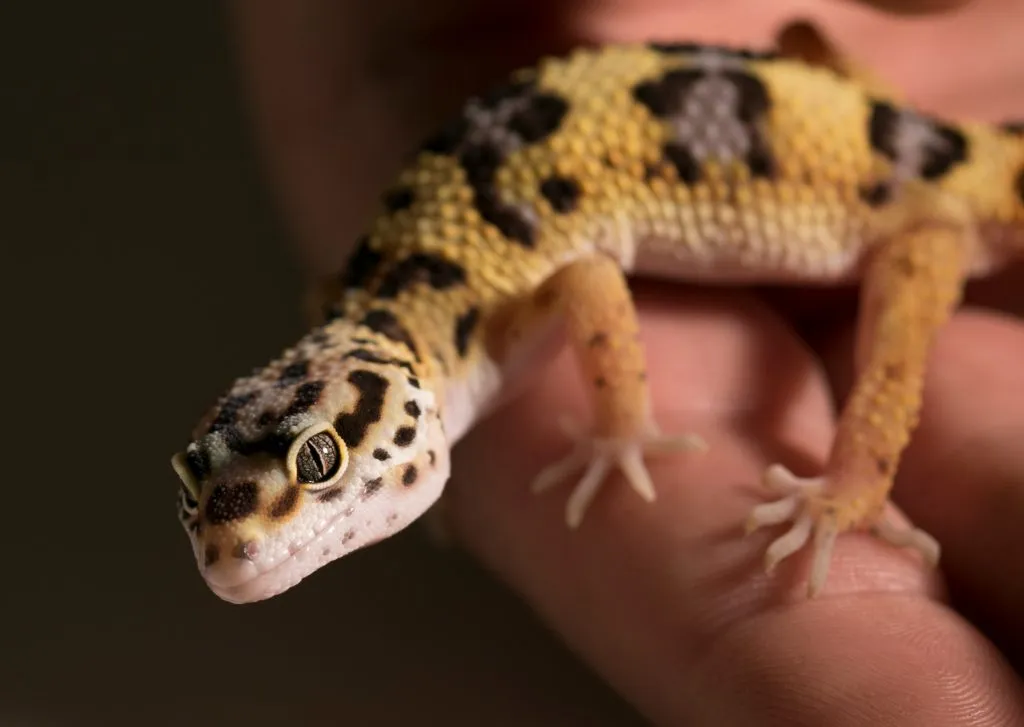
Leopard geckos who are sick or stressed, shouldn’t be handled as it can cause the animal to feel even worse and may hinder their recovery.
The only exception to this is a veterinarian who may need to handle a sick or stressed leopard gecko to determine the cause of the problem. If you think that your leopard gecko is sick, it’s best to contact a reptile veterinarian.
We’ve listed some signs of illness in leopard geckos below (source):
- Difficulty breathing
- Gaping mouth
- Thin tail (also known as pencil tail)
- Decreased activity (lethargy)
- Weight loss
- Material exiting or surrounding the eyes, nose, or mouth
- Vomiting
- Diarrhea
- Swellings or lumps.
Disclaimer: Please refer to the above list as a guide only. If you think that your leopard gecko might be sick, contact a reptile veterinarian.
It’s good practice to weigh your leopard gecko every few weeks so you can spot changes in its weight more easily.
Signs that your leopard gecko may be stressed include:
- Licking their
tank or object inside it - Vocalization
- Waving
- Hiding
- Glass surfing.
If your leopard gecko shows the above behavior, it’s best not to handle them and to look for a possible cause of stress, such as incorrect
You can check that all the parameters in your leopard gecko’s
You can read more about stress in leopard geckos in our article ’11 Things That Will Stress Your Leopard Gecko’.
When They Are Brumating
Brumation is a process performed by many reptile species in response to reduced temperature and allows them to conserve energy at a time when
When leopard geckos are brumating, they will be less active than usual, lose their appetite, and may hide (especially in cooler areas of their
It’s important not to handle, disturb or try to feed your leopard gecko whilst they are brumating. Brumation can last for a few months and is nothing to worry about in a healthy leopard gecko.
When They Are Shedding
Although it’s an especially interesting time, it’s important not to handle leopard geckos during or soon after they finish shedding.
It’s best to wait a few days after they’ve finished shedding before starting to handle them again.
This is because they are especially sensitive during this time, and you may cause them to become stressed. Stressed leopard geckos may have trouble shedding, which can lead to retained shed (dysecdysis).
Signs that your leopard gecko may soon start shedding include:
- Dull or pale skin color
- Hiding
- Being more irritable or less social than usual.
Aside from leaving them to shed in peace, it’s also especially important to check that your leopard gecko’s
Handlers With a Weaker Immune System
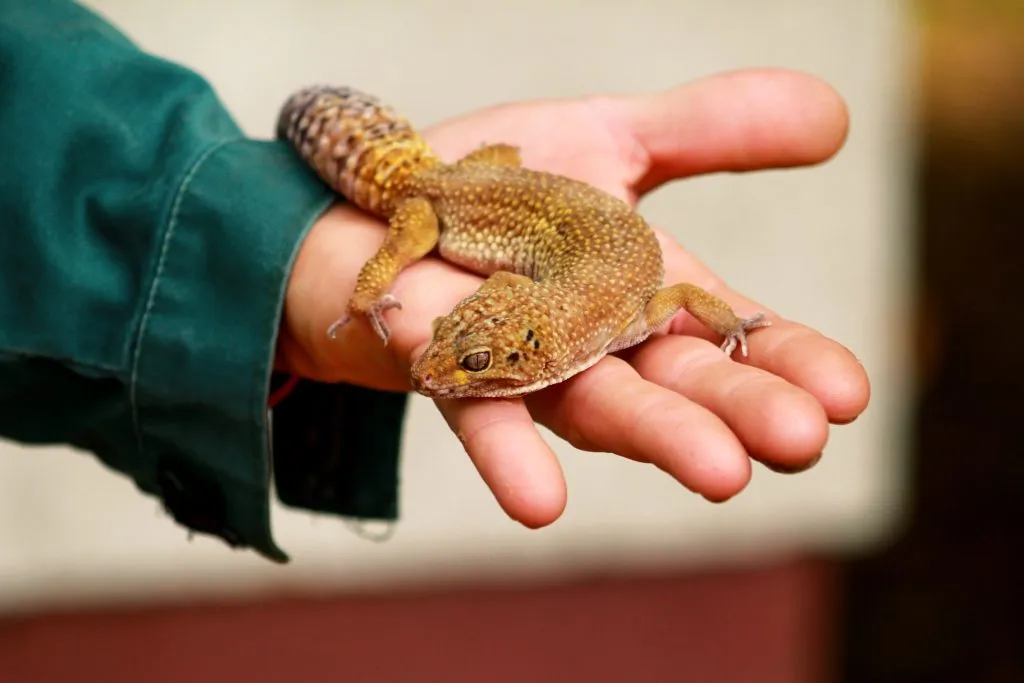
Since leopard geckos can be a source of the bacteria salmonella, it’s not recommended for people who are at risk to handle these animals.
As we explained already, salmonellosis isn’t usually a serious disease in people with a fully functioning immune system.
It’s usually preventable by humans washing their hands after handling geckos or touching anything they’ve come into contact with.
People with a weaker immune system, such as those who are immunosuppressed due to health conditions or medication, children younger than 5 years old, or adults over the age of 65 are more likely to suffer from more severe salmonellosis.
So it’s best to eliminate any risks by not letting immunosuppressed people come into contact with leopard geckos.
Conclusion
We hope you’ve enjoyed reading this article almost as much as you enjoy handling your leopard gecko! Now you know everything you need to know to make handling time just as enjoyable for your pet, as it is for you.
You can read more about leopard geckos happy in our article ’13 Signs Your Leopard Gecko Is Happy And Healthy’.
- Enchi Ball Python: A Unique and Stunning Morph of Python regius - March 27, 2025
- Emerald Tree Monitor: The Enigmatic Green Guardian of the Rainforest - March 26, 2025
- The Egyptian Cobra (Naja haje): A Fascinating Serpent - March 25, 2025
